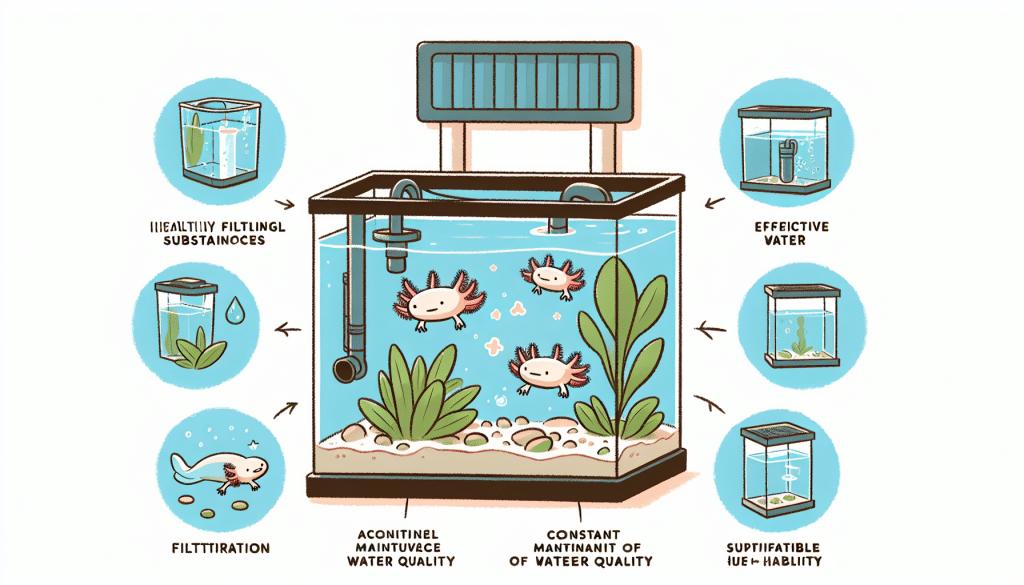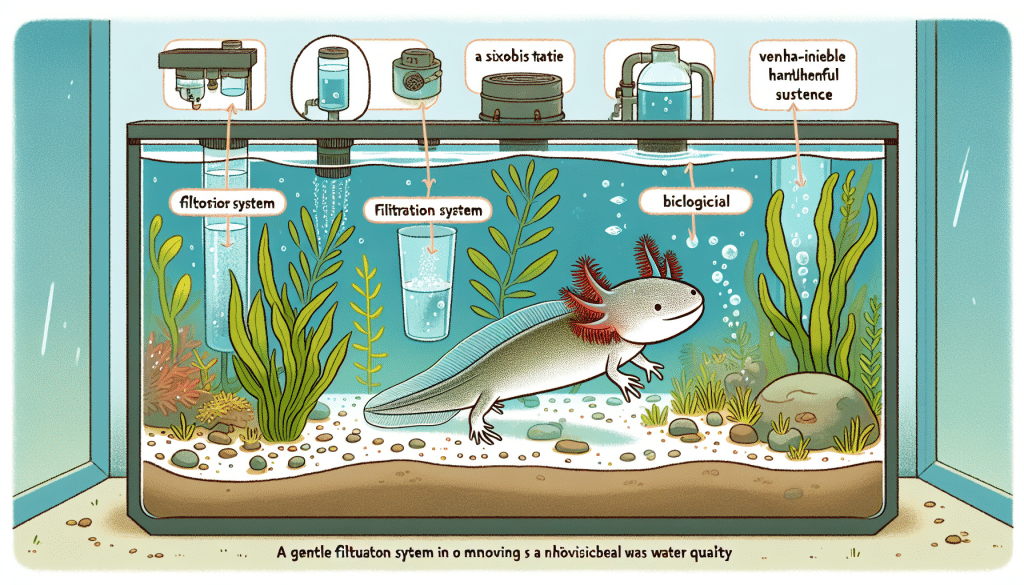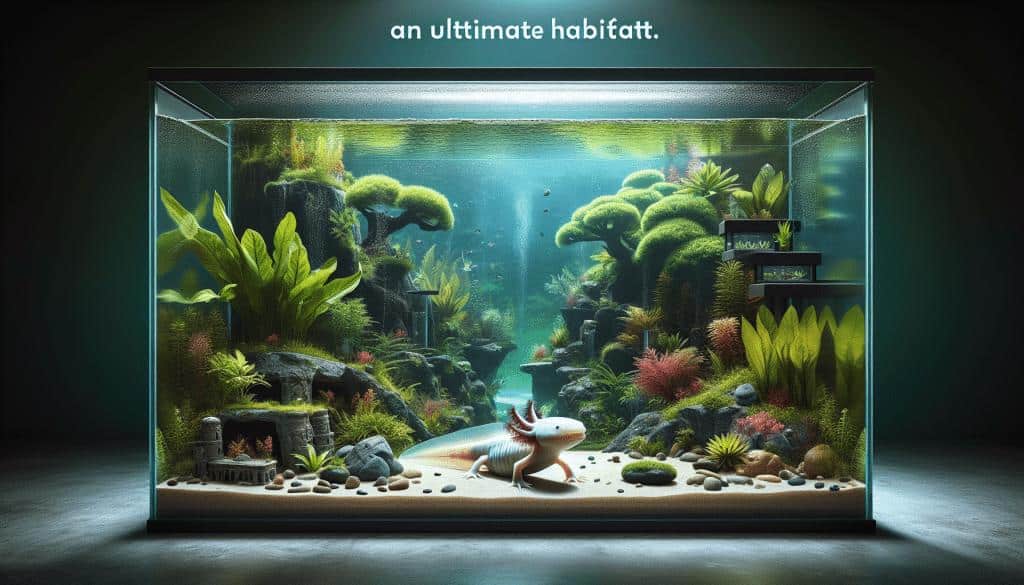Axolotls, a unique species of salamander, require specific environmental conditions to thrive in captivity. One crucial aspect of maintaining a healthy axolotl habitat is proper filtration. Filtration not only enhances the water quality in axolotl tanks, but it also plays a vital role in their overall well-being. This article explores the significance of filtration for axolotl tanks, highlighting its impact on water quality, disease prevention, and the promotion of optimum growth and development for these captivating aquatic creatures.
Understanding Axolotl Requirements
Axolotls are unique creatures with fascinating biology. To ensure their optimal health and well-being in captivity, it is crucial to provide them with the right conditions. One of the key factors in maintaining a healthy axolotl habitat is proper filtration. In this article, we will explore the different aspects of axolotl filtration, from understanding their unique biology to choosing the right filtration system and maintaining water quality.

Unique Biology of Axolotls
Before delving into the specifics of axolotl filtration, it is essential to understand the unique biology of these amphibians. Axolotls are neotenic, which means they retain their juvenile characteristics throughout their lives and remain aquatic. Unlike most amphibians, they do not undergo metamorphosis into land-dwelling creatures. As a result, axolotls require an aquatic environment that closely mimics their natural habitat to thrive.
Water Parameters for Optimal Health
Maintaining appropriate water parameters is crucial for the well-being of axolotls. The temperature of the water should be kept between 60 to 68°F (15 to 20°C) to mimic their natural habitat in Lake Xochimilco. It is also essential to monitor pH levels, which should ideally be between 6.5 to 7.5. Axolotls are particularly sensitive to ammonia and nitrites, so regular testing of these levels is necessary.

The Role of Filtration in Axolotl Tanks
Filtration plays a vital role in maintaining the water quality of axolotl tanks. It helps remove harmful substances, control waste products, and maintain the pH and nitrogen cycle. Effective filtration not only ensures the overall health and well-being of axolotls but also reduces the frequency of water changes and the risks associated with poor water quality.
Types of Filtration Systems
There are three main types of filtration systems commonly used in axolotl tanks: mechanical filtration, biological filtration, and chemical filtration. Each type serves a specific purpose and contributes to the overall effectiveness of the filtration system.
Mechanical Filtration
Mechanical filtration involves removing debris and particulate matter from the water. This is typically achieved by passing the water through a physical barrier, such as filter sponges or filter floss. Mechanical filtration helps prevent clogging in the biological and chemical filtration components and improves water clarity.
Biological Filtration
Biological filtration is the most crucial aspect of axolotl tank filtration. It relies on beneficial bacteria to break down toxic ammonia and convert it into less harmful substances. The bacteria colonize filter media, such as ceramic rings or bio balls, where the water passes through, providing a large surface area for the bacteria to thrive.
Chemical Filtration
Chemical filtration involves the use of various chemical media, such as activated carbon or zeolite, to remove impurities or toxins from the water. This type of filtration is particularly useful in removing medications or other chemicals that may be harmful to axolotls. However, it is important to note that chemical filtration should be used sparingly and only when necessary to avoid unnecessary removal of beneficial substances.
Pros and Cons of Different Filter Types
Each type of filtration system has its pros and cons. Mechanical filtration efficiently removes debris, but it may require frequent cleaning and maintenance. Biological filtration is essential for maintaining a healthy nitrogen cycle, but it takes time to establish the beneficial bacteria. Chemical filtration provides an additional layer of water purification, but it may remove essential nutrients. It is crucial to strike a balance and choose a filtration system that meets the specific needs of axolotls.

Filtration and Water Quality
Maintaining optimal water quality is of utmost importance for the health of axolotls. Effective filtration plays a crucial role in achieving and maintaining water quality standards by addressing several key aspects.
Removing Harmful Substances
Through mechanical filtration, debris, uneaten food, and other unwanted particles are removed from the water, preventing their accumulation and potential harm to axolotls. This not only improves water clarity but also reduces the risk of clogged gills or digestive issues in the axolotls.
Control of Waste Products
Axolotls are notorious for their high waste production. By providing adequate biological filtration, the beneficial bacteria can break down the toxic ammonia produced by axolotl waste into less harmful nitrites and eventually nitrates. This prevents ammonia poisoning and helps maintain a healthy environment for axolotls.
Maintenance of pH and Nitrogen Cycle
Proper filtration and biological activity play a crucial role in maintaining the pH balance of the water. The accumulation of ammonia can lead to increased acidity, which can be detrimental to the health of axolotls. Additionally, the nitrogen cycle, maintained by biological filtration, ensures the conversion of toxic ammonia and nitrites and helps stabilize the overall water chemistry.
Importance of Filter Maintenance
Regular maintenance of the filtration system is vital for its effectiveness and the well-being of axolotls. Mechanical filter media should be cleaned or replaced regularly to prevent clogging and maintain optimal flow. Biological filter media need to be handled with care to preserve the beneficial bacteria colonies and should only be rinsed in tank water or dechlorinated water. Neglecting filter maintenance can lead to poor water quality and compromised health for axolotls.
Filtration Flow Rate
The flow rate of the filtration system is an important aspect to consider when setting up an axolotl tank. The flow rate refers to the speed at which water passes through the filter. It is essential to strike a balance between efficient filtration and creating a suitable environment for axolotls.
Flow Rate and Its Impact on Axolotls
High flow rates can create turbulence and stress axolotls, potentially interfering with their ability to swim and hunt for food. On the other hand, low flow rates may not provide adequate filtration and can lead to stagnation, encouraging the growth of harmful bacteria or algae. Finding the optimal flow rate is crucial for maintaining a healthy and comfortable habitat for axolotls.
Adjustable Flow Rate Filters
Some filtration systems offer adjustable flow rates, allowing the owner to customize the water movement in the tank. This feature is particularly useful for axolotl tanks, as it enables fine-tuning of the flow to meet the preferences and needs of the individual axolotls.
How to Determine the Optimal Flow Rate
To determine the optimal flow rate for axolotls, it is advisable to observe their behavior. If the axolotls appear stressed or struggle against the current, the flow rate may be too high. Conversely, if there are stagnant areas or accumulation of debris, the flow rate may be too low. Adjustments can then be made to achieve the ideal flow rate, ensuring both filtration efficiency and the well-being of the axolotls.
Filter Media Options
Choosing the right filter media is essential for effective axolotl tank filtration. Various types of filter media are available, each offering different benefits and considerations.
Sponge Filters
Sponge filters are commonly used in axolotl tanks due to their gentle water movement and biological filtration capabilities. They provide a large surface area for beneficial bacteria colonization and can be easily cleaned or replaced. Sponge filters are an excellent choice for tanks with axolotl hatchlings or juveniles, as they also prevent the small axolotls from being sucked into the filter.
Canister Filters
Canister filters offer excellent mechanical and biological filtration capabilities. They are typically placed outside the tank and require some space for installation. Canister filters are known for their strong flow rates and large media capacity, making them suitable for larger axolotl tanks. However, their higher initial cost and more complex setup should also be considered.
HOB (Hang-On-Back) Filters
HOB filters are another popular choice for axolotl tanks. They are easy to install and maintain, making them suitable for beginners. HOB filters hang on the back of the tank, providing mechanical and biological filtration. However, due to their design, the flow rate may be stronger compared to sponge filters, requiring adjustments to suit the needs of axolotls.
Customizing Media for Axolotl Tanks
Regardless of the type of filter chosen, it is important to consider the specific needs of axolotls when selecting filter media. Ceramic rings, bio balls, or other porous materials are commonly used for biological filtration as they provide ample surface area for beneficial bacteria colonization. Including additional mechanical filtration media, such as filter floss or sponges, can further enhance water clarity and debris removal.
Setting Up the Filtration System
Properly setting up the filtration system is crucial for its effectiveness and the health of axolotls. Consider the following steps to ensure a well-functioning filtration system in an axolotl tank.
Positioning Your Filter
The placement of the filter is important to distribute the flow and provide efficient filtration. Ideally, place the filter at one end of the tank to create a gentle current that flows across the tank. This helps prevent stagnant areas and ensures proper water circulation. Avoid placing the filter directly below any decorations or the substrate, as it may lead to debris accumulation and reduced filter efficiency.
Initial Cycling Process
Before introducing axolotls to a newly set up tank, it is essential to cycle the tank to establish the beneficial bacteria required for biological filtration. Cycling involves adding an ammonia source, such as pure ammonia or fish food, and allowing time for the bacteria to develop and establish themselves. Regular water testing during this process is crucial to monitor the progress and ensure the water is safe for axolotls.
Avoiding Common Setup Mistakes
When setting up the filtration system, it is important to avoid common mistakes that may compromise water quality or the health of axolotls. These include overcrowding the tank, using inadequate filter media, insufficient water flow, and inadequate tank size. Taking the time to research and plan the tank setup can help prevent these mistakes and provide a suitable environment for axolotls.
Tank Cleaning and Filter Maintenance
Regular tank cleaning and filter maintenance are essential for maintaining optimal water quality and the health of axolotls. Establishing a routine cleaning schedule, knowing when to replace filter media, and troubleshooting common filter issues are important aspects of axolotl tank maintenance.
Routine Cleaning Schedule
It is recommended to perform regular water changes of 10-20% every 1-2 weeks to control nitrate accumulation and maintain water quality. During these water changes, the filter media should be inspected and cleaned if necessary. Additionally, vacuuming the substrate and removing any uneaten food or waste can help prevent the buildup of harmful substances and maintain a clean environment.
Replacing Filter Media
Filter media, especially mechanical media, may require periodic replacement to maintain its effectiveness. The frequency of replacement depends on factors such as the load on the filter and the accumulation of debris. Biological media, on the other hand, should be handled with care to preserve the beneficial bacteria colonies. It is advisable to only rinse these media in tank water or dechlorinated water to avoid killing the bacteria.
Troubleshooting Common Filter Issues
Filter issues can occasionally arise, affecting filtration efficiency and water quality. Common problems include reduced flow rate, noisy operation, or clogged media. Regular inspection and maintenance can help prevent these issues. In case of problems, it is advisable to consult the manufacturer’s instructions or seek guidance from experienced aquarists to diagnose and rectify the issue promptly.
Addressing Filtration Challenges
Certain filtration challenges may arise when keeping axolotls. It is important to be aware of these challenges and implement suitable solutions to ensure the well-being of axolotls.
Dealing with Overfiltration
Overfiltration, or excessive filtration, can be a concern for axolotl tanks. Strong water flow can stress axolotls and disrupt their natural behavior. To address this, flow regulators or diffusers can be used to reduce the flow rate of the filtration system. Alternatively, positioning decorations or live plants strategically can help redirect and diffuse the flow, creating a more comfortable environment for axolotls.
Managing Low Oxygen Levels
Axolotls require sufficient oxygen in the water to breathe adequately. Overstocking the tank, poor water circulation, or the use of dense decorations can impede oxygen exchange and lead to low oxygen levels. To address this issue, additional aeration can be provided through the use of airstones or bubblers. These increase surface agitation and promote oxygen diffusion, ensuring a healthy environment for axolotls.
Filtration Solutions for Axolotl Diseases
Axolotls can be prone to certain diseases, such as fungal or bacterial infections, which may require specific filtration solutions. Adding appropriate treatment media, such as activated carbon or specific medications, to the filtration system can help remove toxins or unwanted substances and aid in the recovery of sick axolotls. It is important to consult a veterinarian or experienced aquarist for guidance when dealing with axolotl diseases.
Additional Filtration Considerations
Beyond the basic filtration components, there are additional factors to consider when setting up an axolotl tank to further enhance water quality and the overall well-being of axolotls.
The Role of Live Plants
Live plants not only add aesthetic value to the tank but can also contribute to water quality improvement. They help absorb excess nutrients, produce oxygen during photosynthesis, and provide additional hiding places for axolotls. However, not all plant species are suitable for axolotl tanks, as they may be nibbled on or cause harm to the axolotls. Researching axolotl-safe plant options is essential when considering adding live plants to the tank.
Use of Airstones and Bubblers
Airstones or bubblers are commonly used in aquariums to increase water movement and provide additional aeration. While axolotls do not require high levels of water aeration, the use of airstones or bubblers can help maintain proper oxygen levels in the tank and promote a healthy environment. However, it is important to strike a balance to avoid excessive disturbance to axolotls.
Compatibility with Tank Decorations
When choosing tank decorations, it is important to consider their compatibility with the filtration system and the needs of axolotls. Avoid decorations with sharp edges or small openings that may injure or trap axolotls. Additionally, select decorations that are easy to clean and maintain, as accumulated debris can compromise water quality and filtration effectiveness.
Educating on Filtration
Understanding the importance of filtration is crucial for all axolotl owners. By educating yourself and implementing proper filtration practices, you can provide the best possible environment for your axolotls’ health and well-being.
Understanding the Importance of Filtration
Filtration is not just an optional accessory in an axolotl tank; it is a critical component for maintaining optimal water quality. Neglecting filtration can lead to increased ammonia levels, poor water chemistry, and various health issues for axolotls. By understanding the importance of filtration, you can take proactive steps to ensure the long-term health and happiness of your axolotls.
Best Practices for New Axolotl Owners
For new axolotl owners, it is important to establish good filtration habits from the beginning. Research and educate yourself about axolotl tank requirements and different filtration options. Plan and set up the filtration system before introducing axolotls to their new habitat. Regularly monitor water parameters, perform routine maintenance, and seek advice from experienced axolotl enthusiasts or professionals when needed.
Common Misconceptions About Axolotl Filtration
There are several misconceptions surrounding axolotl filtration that can compromise the well-being of these unique creatures. One common misconception is that axolotls do not require filtration due to their aquatic nature. However, axolotls produce significant waste, and inadequate filtration can lead to poor water quality. Another misconception is that any filter will suffice for axolotl tanks. The specific filtration needs of axolotls, such as gentle water movement and biological filtration, should be taken into consideration when selecting a filtration system.
In conclusion, proper filtration is essential for maintaining a healthy and thriving axolotl habitat. Understanding the unique biology of axolotls, choosing the right filtration system, maintaining water quality, and addressing specific challenges are all important aspects of axolotl tank filtration. By adhering to best practices, monitoring water parameters, and providing appropriate care and maintenance, you can create an optimal environment for your axolotls, ensuring their well-being for years to come.

